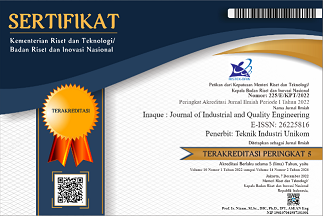IMPROVING EMPLOYEE PERFORMANCE AT THE CREATIVE SILVER CRAFT INDUSTRY IN KOTAGEDE YOGYAKARTA CITY USING HUMAN RELIABILITY ASSESSMENT
DOI:
https://doi.org/10.34010/iqe.v10i2.7192Abstract
The creative industry that focuses on the creation of goods and services by relying on talent, expertise and creativity as intellectual property is the hope for the Indonesian economy, expertise and skills become a very influential central point in this industry. Observations were made at Ira Silver Craft SME which is one of the silver craftsmen SME, where silver is the mainstay of Yogyakarta handicraft industry, the purpose of this study was to measure the level of reliability of workers in the production process of filigree silver ornaments which is one of the silver handicraft products with the complexity of workmanship. and a high risk of human error, knowing the errors that exist in the entire production process, and their causes. This research was conducted using the SPAR-H method. Data from observations showed that the greatest HEP value was found in smelting activities, with a probability of occurrence of 41.78%. In the silver handicraft industry of Kotagede Yogyakarta, there are a total of 10 errors in the final product, the error with the largest probability is a lack of filigree fiber with a probability of 86.84%. Data from observations revealed that work procedures are one of the most significant factors contributing to the occurrence of human error, so Standard Operating Procedures documents are needed to detail all existing work procedures.
Downloads
Published
Issue
Section
License
Authors who publish this journal agree to the following terms:
The author holds the copyright and grants the right of the first publication journal to enable INAQUE to share the work with acknowledgment of the author's work and early publications in this journal.
Authors may include separate additional contractual arrangements for the non-exclusive distribution of the journal's published version (for example, submit to an institutional repository or publish in a book), with the acknowledgment of its initial publication in this journal
Authors are permitted and encouraged to post their work online before and during the delivery process, as it may lead to productive exchanges, as well as quotations of previously published and longer works








